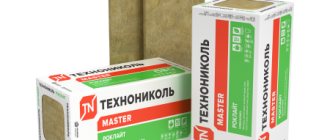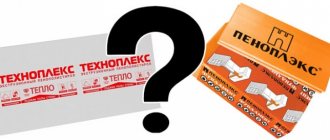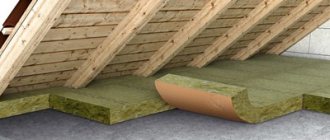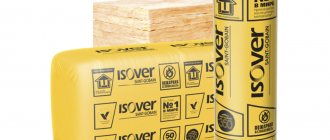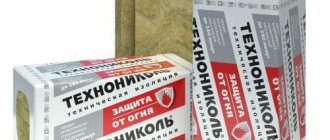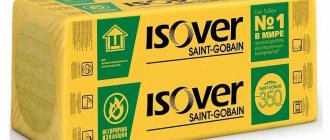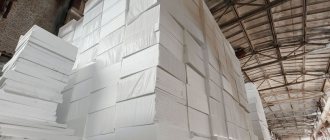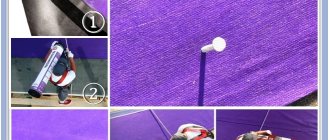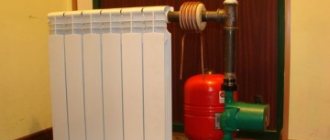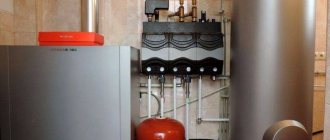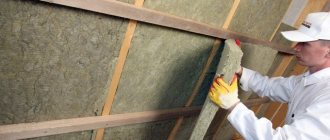Penoplex is the trade name for extruded polystyrene foam, which today is the most popular material for insulating buildings. Extruded polystyrene foam (XPS) is a uniformly structured expanded polystyrene foam that is forced through an extruder under pressure and high temperature. For foaming, carbon dioxide and mixtures of light freons are used. The material, consisting of closed small cells, tightly glued together and filled with air, is both dense and light.
Types and scope
Thanks to modern technologies, TECHNONICOL extruded polystyrene foam is a high-quality and reliable thermal insulation material. It is represented by several types of insulation to solve various thermal insulation problems.
Insulation of cottages and private houses
For private and low-rise construction the following are used:
- XPS TECHNONICOL CARBON ECO – insulation materials designed for thermal insulation of foundations, floors, roofs and insulation;
- TECHNONICOL CARBON ECO SP is a material with increased rigidity designed for insulating foundations that combine an insulated monolithic foundation slab and utilities with a floor heating system. As a rule, ECO SP expanded polystyrene is used in low-rise construction for arranging basements and is suitable for areas with weak-bearing and water-saturated soils, on sand and sandy loam, clay and loam;
- TECHNONICOL CARBON ECO FAS - specially designed for structures of plastered facades, house basements and other objects where increased adhesion of insulation to the base is required;
- TECHNONICOL CARBON ECO DRAIN – slabs with special drainage grooves for organizing wall drainage and thermal insulation of the foundation, as well as creating micro-ventilation in flat roofs and improving water flow;
- TECHNONICOL CARBON SAND – have high moisture resistance and vapor permeability, produced specifically for insertion into sandwich panels. CARBON SAND provides thermal insulation of window slopes that do not freeze in winter. In addition, it speeds up the installation of slopes and simplifies their maintenance.
Application in civil and industrial construction
High strength and lower density characterize thermal insulation intended for use in industrial and civil construction:
- CARBON PROF is a material for professional builders, it has the best thermal conductivity coefficient in the entire line and is used for thermal insulation of foundations, floors, roofs of industrial and civil buildings, including loaded ones, insulation of facades and plinths;
- CARBON PROF SLOPE is a set of five slabs cut from polystyrene foam with a thickness of 40, 70 and 80 mm, with which you can adjust the slope of the roof or change the direction of water flow. Plates A and B have a slope of 1.7%, J and K -3.4%, M - 8.3%.
Application in transport and road construction
Rigid material CARBON SOLID - used to create a thermal insulation layer at the base of transport structures: highways, railway tracks, floors with heavy loads. It is also used in civil engineering, when increased demands are placed on the strength of thermal insulation.
Advantages
Energy efficiency. The material provides high-quality insulation, and this makes it possible to reduce the thickness of the thermal insulation layer. Cold bridges do not form in the insulation layer due to the use of L-edges.
Does not absorb moisture, can be used in high humidity conditions, does not rot, does not swell.
Milled surface with a uniform texture: the quality of thermal insulation installation is improved, the insulation forms a uniform surface that does not need to be additionally prepared for further finishing.
Durable material: does not shrink, does not deform, is protected from damage.
Service life exceeds 50 years.
What is foamed polystyrene
Penoplex is produced by the company of the same name using its original technology and is pressure-foamed, extruded polystyrene. Approximately the same data can be found from open sources about Technoplex insulation produced by the TechnoNIKOL company. The details of the technological process are not reported by Technonikol and Penoplex, but based on fragmentary data, the following conclusion can be drawn:
- Granular raw materials - highly purified polystyrene - are mixed with a gasifier, heated to a high temperature and pressed through calibrated micro-holes;
- When passing through a nozzle with several hundred microholes, the main stream of polystyrene is broken into microfilaments, the polymer molecules are stretched, form bonds with each other and are simultaneously strengthened by pressure;
- At the moment of exiting the dies, polypropylene foams in measured doses and turns into a porous material of millions of tiny frozen bubbles.
The general picture of the production of technoplex and penoplex is the same, but there are slight differences in the composition of the materials and strength characteristics. According to TechnoNIKOL, the technoplex contains a small amount of amorphous carbon or graphite to make it easier for rolling rolls to form a sheet of the required thickness.
House insulation with TECHNONICOL polystyrene foam
Extruded polystyrene foam boards can be used to insulate all surfaces of a private home.
Insulation of foundations
The use of XPS for façade insulation allows one to avoid cold bridges, frost heaving of soils, protect waterproofing, and ensure drainage of groundwater, while reducing their pressure on underground structures and the base.
With traditional foundation insulation, slabs without mechanical fixation are mounted using glue on a waterproofing layer and covered with coarse sand or sand-gravel mixture.
If there is a need to install a shallow foundation, then XPS slabs are laid on the prepared base before waterproofing and pouring the reinforcement frame.
When additionally insulating the basement from the inside, a layer of waterproofing is applied, if necessary, to the leveled walls, XPS boards are fixed onto it using an assembly adhesive compound, then a vapor barrier with foil is laid and secured with polyurethane glue inside the room, vertical guides and sheet trim are installed.
Wall insulation
Walls can be thermally insulated from the inside, outside or inside the building envelope:
- Internal wall insulation is carried out in constructed buildings if quick heating of the room is needed or when the façade cannot be changed. The slabs are pressed against the wall with wooden beams, between which extruded polystyrene foam is also laid, then a vapor barrier film is carefully glued.
- The middle thermal insulation layer in a three-layer masonry allows you to reduce the thickness of the walls. The material used in this layer has high requirements for durability and quality, because if something happens, the masonry will have to be dismantled for repairs. The slabs are attached to the internal load-bearing wall using an adhesive composition; the inner and outer parts are connected to each other by flexible fiberglass ties, which are installed 4-5 pieces per square meter, through thermal insulation. First, a facing layer is laid up to the level of the connections, then thermal insulation is installed with a protrusion in height. The supporting layer is erected to the next level of connections. The layers must be mounted tightly to each other, filling the gaps with dry sand.
- Plaster (“wet”) facade is external thermal insulation, when polystyrene foam slabs are attached to a prepared wall surface using glue and mechanical connectors and covered with several layers of plaster made of synthetic materials and fiberglass.
- If the wall is sheathed with decorative material, clapboard, facade panels or siding, then the thermal insulation slabs are laid out in a checkerboard pattern and fixed to the base with longitudinal slats, on which, in turn, the finishing is mounted.
Roof insulation
lay thermal insulation boards
There are options for thermal insulation of the roof, when slabs of extruded polystyrene foam are attached to the rafters from the inside, and the space between the rafters is also filled. Additional insulation is also possible. Thermal insulation of a pitched roof allows you to avoid cold bridges along rafter structures and create comfortable conditions in the house not only in winter, but also in the summer heat.
Thermal insulation of attic floors
If the attic is not planned to be used as a living space, then it is insulated, not the roof. A flooring of boards or boards is laid on top of the beams, then thermal insulation slabs are laid on it, the joints between them are taped, and a cement-sand screed is made on them and covered with gypsum fiber sheets.
TECHNONICOL extruded polystyrene foam from the company of the same name is an effective thermal insulation that allows you to save heating costs and provides reliable insulation for many years to come for almost any building structure.
Tips for choosing
To ensure that the quality of insulation with TechnoNIKOL extruded heat insulator meets the necessary requirements, it is worth taking note of several recommendations.
It is necessary to pay attention to the markings. It indicates the purpose of each material. The purchase should be made in a trusted store with positive customer reviews. You can scroll through the comments of professional construction experts in advance
In addition to the advantages, they usually indicate the disadvantages of a particular material.
The material is selected taking into account a special calculation. This will allow you to buy the right quantity. The formula is quite simple: the height of the walls is multiplied by the perimeter of the walls, then multiplied by the thickness, and then multiplied by the mark indicated by the manufacturer on the cubic meter marking. With a wall height of 3 m, a perimeter of 24 m, an insulation thickness of 5 cm (0.05 m) and a packaging volume of 0.36 m3, the result is:
- 3 x 24 = 72 (m2);
- 72 x 0.05 = 3.6 (m3);
- 3.6/0.36 = 10 (packs).
You will learn more about TechnoNIKOL Carbon products in the following video.
Geometric parameters
| Indicator name | Unit change | Criterion | Meaning | Test method |
| Thickness | mm | within | 3 0 – 100** | GOST 17177-94 |
| Length | mm | within | 1180, 1200*** | GOST 17177-94 |
| Width | mm | within | 580, 600*** | GOST 17177-94 |
* - thermal conductivity measured within 24 hours from the moment of product release; ** - slabs with a thickness of 80 mm or more can be produced using the ThermoBonding method; *** - upon agreement with the consumer, it is possible to produce slabs of other sizes.
| Thickness, mm | 30 mm | 40 mm | 50 mm | 100 mm |
| Width, mm | 580 | 580 | 580 | 580 |
| Length, mm | 1180 | 1180 | 1180 | 1180 |
| Area of one slab, m2 | 0,68 | 0,68 | 0,68 | 0,68 |
| Number of slabs per package | 13 | 10 | 6 | 4 |
| Product area in one package, m2 | 8,9 | 6,8 | 4,1 | 2,7 |
| Product volume in one package, m3 | 0,27 | 0,27 | 0,2 | 0,27 |
| Weight of one package, kg | 8,0 | 8,2 | 6,2 | 8,2 |
Features of installation of extruded polystyrene foam from TechnoNIKOL
For foundation insulation, the best option is the CARBON DRAIN slab. On the outside of the material there are grooves for water drainage. Thermal insulation is attached to a layer of bitumen mastic, which does not contain solvents. Up to ground level, the insulation does not need to be coated, but the ground floor will require a decorative layer of plaster.
Installation of insulating boards on the walls of a building occurs using glue, applied dotted or in strips. Additional fixation is provided by disc-shaped plastic dowels. There are 4-5 of them per stove. The insulation sheets are laid in a checkerboard pattern, the seams are blown in with foam. The insulation requires protection with a layer of plaster. For strong adhesion, a reinforcing mesh is attached under the solution.
Floor insulation with CARBON ECO products is especially important for the first floor of a building. The slabs are laid after creating a sand-crushed stone backfill and covering it with a layer of waterproofing. The material in the area of the joints is taped or completely covered with polyethylene. This procedure prevents grout from getting between the XPS sheets. On top of the thermal insulation, two layers of plasterboard are attached or a concrete screed is applied under the finishing coating. When installing a “warm floor,” the heating cable is laid out on insulation boards and filled with cement mortar.
Thermal insulation of a flat roof with Carbon slabs begins with preliminary fusion of waterproofing. The slabs are laid on a roll sheet with the seams staggered. The material is covered with ballast, such as gravel, on top.
Features and production of extruded polystyrene foam
The material is produced in an extruder, where a mixture of polystyrene granules and a blowing agent is heated and extruded. An additive to the polymer is carbon dioxide, which makes it possible to obtain high-quality and environmentally friendly insulation. Extruded polystyrene foam produces a uniform structure with closed cells measuring 0.1-0.2 mm.
The insulation with small pores and a rigid frame is strong and durable; it does not shrink during operation. Its thermal conductivity and water absorption are characterized by coefficients that are low even for materials of similar purposes.
The disadvantage of Carbon is its flammability, but the insulation does not emit dangerous toxic substances.
Characteristics and properties of XPS CARBON
- thermal conductivity at 25º C - 0.029-0.031 W/m*K;
- water absorption is - 0.2;
- vapor permeability in the range - 0.011-0.005;
- modulus of elasticity - 17;
- operating temperature - from −70º to +75º C;
- density - 26-60 kg/m3;
- flammability class - G3-G4;
- service life - up to 50 years.
Closed cells in the structure of the material ensure minimal water absorption; the insulation does not swell when in a humid environment. Carbon does not rot, is chemically resistant, and is not susceptible to biological effects. The insulation is lightweight, it does not load the structure and is easy to install. Available in the form of slabs with thicknesses from 3 to 100 mm.
Delivery by our transport is carried out in Moscow and the Moscow region
In this case, payment can be in two ways:
Payment upon delivery (This will allow you to be convinced of the proper quality of our building materials, and then make a payment to our driver)
Payment by card (If the transfer is planned upon delivery of building materials, in this case we take an advance payment equal to the delivery amount and + 1% commission for withdrawing money)
Prices for delivery of building materials in Moscow:
| Product weight | Delivery price |
| Up to 1.5 tons | from 2100 rubles |
| Up to 2.5 tons | from 2600 rubles |
| Up to 5 tons with crane | from 6800 rubles |
| Up to 7 tons with crane | from 6800 rubles |
| Up to 8 tons with crane | from 7800 rubles |
| Up to 12 tons with crane | from 11,000 rubles |
Prices for delivery of building materials in the Moscow region:
| Product weight | Delivery price |
| Up to 1.5 tons | from 1900 rubles + 30 rubles per km |
| Up to 2.5 tons | from 2500 rubles + 30 rubles per km |
| Up to 5 tons with crane | from 6800 rubles + 50 rubles per km |
| Up to 7 tons with crane | from 6800 rubles + 50 rubles per km |
| Up to 8 tons with crane | from 7500 rubles + 50 rubles per km |
| Up to 12 tons with crane | from 9500 rubles + 50 rubles per km |
We also provide services:
| Ascent to the apartment (availability of a freight elevator) | Unloading price |
| Up to 100 kg | 250 rub. (no more than 2 meters in the apartment) |
| From 101 to 500 kg | 1 rub. for 1 kg (no more than 2 meters in the apartment) |
| From 501 to 10000 kg | 0.9 rub. for 1 kg (no more than 2 meters in the apartment) |
| Ascent to the apartment (without elevator) for each floor | Unloading price |
| Up to 30 kg | 2.6 rub. (no more than 2 meters in the apartment) |
| From 31 to 60 kg | 2 r. for 1 kg (no more than 2 meters in the apartment) |
| From 61 to 100 kg | 1.6 rub. for 1 kg (no more than 2 meters in the apartment) |
| From 101 to 500 kg | 1.3 rub. for 1 kg (no more than 2 meters in the apartment) |
| From 501 to 1000 kg | 1 rub. for 1 kg (no more than 2 meters in the apartment) |
| From 1001 to 10000 kg | 0.9 rub. for 1 kg (no more than 2 meters in the apartment) |
Unloading on the ground 0.5 rubles per 1 kg
Lifting of Drywall, Profile, OSB, and other dimensional Materials are calculated separately with the manager
Return Policy
- Returns are made within 14 days from the date of purchase. The goods are delivered to the shipping warehouse (check with managers) or you can use the delivery and loading service. Price according to price or individually.
- Products sold by the meter (measured, cut), damaged, expired, or in poor presentation are not subject to return.
When unloading and lifting, cleaning the entrance, removing garbage and other ensuing consequences after lifting the building material are not included in the price. Prepare in advance for the service you ordered. Thanks for understanding !
Technology and installation stages
Installing extruded polystyrene foam yourself is not difficult. If the facade is insulated, all the main types of work inside should already be done. This also applies to window and door openings, as well as the roof of the building.
Installation consists of several successive steps.
- Purchase the required amount of glue and insulation, taking into account the calculation of the number of packages.
- Prepare the necessary equipment to simplify the work process.
- The insulation must be fixed to a flat base. To do this, the surface is leveled and obvious bumps are removed.
- In order for the glue to better hold the thermal insulation, you need to remove the dust with a damp cloth. Then the surface should dry.
- You need to get rid of dirt and grease. They will reduce adhesion.
- After this, a layer of primer is applied to the surface. It is better to use soil with maximum penetrating ability. This will even out the base structure and bind dust and microcracks.
- Large cracks are covered with cement-based plaster. Then these places are primed again. The soil layer must dry before fixing the insulation.
- Make markings and attach the profile to the base. Its width should be equal to the thickness of the insulation used.
- Glue is applied to the back side of the insulation using the dot method. You can apply it in stripes.
- The plate is applied to the base and pressed tightly. This is how the sheathing of the required area is carried out. At the same time, we must not forget to fasten the plates to each other.
- After fixing, waterproofing is laid. Typically, a thin film is used, which is placed on the frame within 2–3 cm of the insulation.
- All that remains is to complete the finishing touches on top of the thermal insulation.
Basic physical and mechanical characteristics
| Indicator name | Unit change | Criterion | Meaning | Test method |
| Compressive strength at 10% linear deformation: 3 0 – 39 mm ≥ 40 mm | kPa | no less | 100 150 | GOST 17177-94 |
| Flexural strength | kPa | no less | 100 | GOST 17177-94 |
| Thermal conductivity at (25±5) ºC *: < 40 mm 40 – 79 mm ≥ 80 mm | W/(m•K) | no more | 0,032 0,033 0,037 | GOST 7076-99 |
| Thermal conductivity under operating conditions “A and B” | W/(m•K) | no more | 0,034 | GOST 7076-99 |
| Water absorption by volume | % | no more | 0,7 | GOST 15588-2014 |
| Vapor permeability coefficient | mg/(m•h•Pa) | — | 0,014 | GOST 25898-2012 |
| Flammability group | — | — | G4 | GOST 30244-94 |
| Flammability group | — | — | AT 2 | GOST 30402-96 |
| Smoke generation group/toxicity | — | — | D3/T2 | GOST 12.1.044-89 |
| Operating temperature | ºC | within | from -70 to +75 | STO 72746455-3.3.1-2012 |
Additional opinions
According to them, the most important characteristic of the material is its high heat-saving ability. When installing a layer of 10 cm, you will provide the house with optimal insulation in most climatic zones of Russia
Home craftsmen emphasize that the material exhibits exceptional strength, due to which it does not settle or change shape during its service life. This indicates that the finishing coating of the base, walls and blind area, which are insulated with this material, will retain their original condition for quite a long time.
XPS TECHNONICOL CARBON ECO is used in cottage and low-rise construction for thermal insulation of foundations, roofs, floors, and insulation of facades.
Other products in the line
TECHNONICOL CARBON ECO SP
TECHNONICOL CARBON ECO FAS
TECHNONICOL CARBON ECO DRAIN
XPS TECHNONICOL CARBON ECO
– an ideal solution
for insulating your cottage.
It does not absorb water, does not swell or shrink, is chemically resistant and does not rot. This is an excellent thermal insulation material for those looking for high-quality thermal insulation with high performance.
Extruded polystyrene foam TECHNONICOL CARBON ECO
is one of the most highly effective thermal insulation materials. High strength and low thermal conductivity determine the popularity of the material in cottage and private house construction.
In the production of XPS TECHNONICOL CARBON ECO
Nano-sized carbon particles are used.
Nanocarbon reduces the thermal conductivity of the material and increases its strength. , XPS TECHNONICOL CARBON ECO
boards acquire a dark silver color and have high energy efficiency.
Line of XPS brand materials TECHNONICOL CARBON ECO
created for use in cottage and low-rise construction.
The line includes a special material for organizing drainage XPS TECHNONICOL CARBON ECO DRAIN
, a material for plaster facade insulation systems
XPS TECHNONICOL CARBON ECO FAS
and a material used in the construction of an insulated Swedish plate -
TECHNONICOL CARBON ECO SP
. All materials in this series are certified in environmental laboratories and have appropriate conclusions.
XPS material
insured for €1 million.
In accordance with the terms of the contract, it undertakes to compensate for damage caused to the life, health or property of the consumer due to any defects in the product. XPS TECHNONICOL CARBON ECO
undergoes voluntary certification “Leaf of Life”, which confirms the safety of use in housing construction.
The wide product range includes specialty products:
XPS TECHNONICOL CARBON ECO SP
– high-strength thermal insulation boards, 100 mm thick. They are used as part of a shallow foundation system with a system of ready-made communications and heated floors. Technology “Insulated Swedish stove”;
XPS TECHNONICOL CARBON DRAIN
– special thermal insulation of the foundation providing wall drainage;
XPS TECHNONICOL CARBON ECO FAS
– a convenient solution for plaster facades in low-rise construction. The products contain fire retardants that reduce the risk of fire. The slabs have a special rough surface, which contributes to better adhesion of the plaster layer.
Advantages
Biostability (resistant to insects and rodents);
Saves your money due to better thermal insulation properties per m²;
Retains heat 1.5 times more efficiently than conventional foam plastics and 2 times more efficiently than stone and glass wool;
Not afraid of moisture;
Does not shrink over time;
Does not contain formaldehyde. Does not emit harmful substances throughout its entire service life;
Odorless;
Convenience and ease of use;
High installation speed;
Stable characteristics throughout the entire service life;
Service life over 50 years.
Characteristics
TECHNONICOL CARBON ECO
Compressive strength at 10% linear deformation, not less, kPa
Thermal conductivity at (25±5)0С, W/(m*K), no more
Thermal conductivity under operating conditions “A and B”, W/(m*K), no more
Extruded polystyrene foam has established itself as the optimal choice for thermal insulation of buildings. The technical characteristics and properties of insulation make it possible to solve the problem of energy loss at any construction site from the foundation to the roof. TechnoNIKOL company offers XPS CARBON - a thermal insulation material designed for use in private and industrial construction, as well as in the construction of airfields, roads and railways.
Extruded polystyrene foam
TECHNONICOL XPS extruded polystyrene foam is a thermal insulation material with evenly distributed closed cells. TECHNONICOL XPS does not absorb water, does not swell or shrink, is chemically resistant and does not rot.
High strength allows you to obtain a flat and at the same time rigid base, which significantly increases the service life of the entire thermal insulation system.
Application area:
TECHNONICOL XPS is used in general civil construction for thermal insulation of foundations, roofs, floors, and insulation of facades.
Extruded polystyrene foam (or extruded polystyrene foam) is a new word in the field of thermal insulation technologies. Even though the material began to be produced more than 60 years ago, it still has no analogues either in Russia or in the world. Expanded polystyrene TECHNONICOL XPS is a universal insulation material in all respects.
Firstly, extruded polystyrene foam allows for effective thermal insulation of a wide variety of objects, structures and structures. In other words, it has a truly wide scope of application. TECHNONICOL XPS is used for thermal insulation of floors, walls, foundations, roofs, as well as various engineering structures and roads. Thus, extruded polystyrene foam is used in both industrial and private construction.
Secondly, TECHNONICOL XPS insulation has unique technical characteristics. Extruded polystyrene foam has one of the lowest thermal conductivity values among other similar products. In addition, TECHNONICOL XPS is characterized by chemical resistance, high compressive strength, water and vapor impermeability, as well as resistance to the formation of mold and mildew. Thus, TECHNONICOL XPS extruded polystyrene foam not only provides thermal insulation, but also effectively prevents the effects of a number of other destructive and negative factors.
In addition, extruded polystyrene foam belongs to the class of environmentally friendly materials, which makes it unrivaled among other insulation materials.
TECHNONICOL Corporation produces extruded polystyrene foam using the most modern technologies and the latest equipment, which allows us to produce truly high-quality, reliable and durable thermal insulation material. The company's product range includes several types of TECHNONICOL XPS, aimed at optimally solving thermal insulation problems.
XPS TECHNOPLEX, TECHNONICOL CARBON ECO, TECHNONICOL CARBON ECO FAS, TECHNONICOL CARBON ECO SP, TECHNONICOL CARBON PROF, TECHNONICOL CARBON PROF SLOPE, TECHNONICOL CARBON SOLID, TECHNONICOL CARBON SAND . These types of extruded polystyrene foam differ in terms of compressive strength, water absorption, as well as thermal conductivity coefficients under different operating conditions.
Properly selected extruded polystyrene foam is an effective solution to problems with thermal insulation for many years to come, high savings on heating costs and a guarantee of durability of structures and structures.
Where can I buy? Who will install it? Proven solutions for your construction. TechnoNIKOL systems. Extruded polystyrene foam
Features and production
"TechnoNIKOL" Carbon is extruded polystyrene foam. These are carbon-based insulation with low thermal conductivity. Carbon microparticles are used in its production. This helps to reduce the level of thermal conductivity and increase the strength of the insulation. Due to the saturation with nanocarbon, the line of materials is characterized by a light silvery tint.
This is one of the best energy-efficient insulating materials of the brand. It is distinguished by its stable geometric shape, regardless of service life. It does not shrink like other varieties from other lines. The line includes materials for amateurs and professional craftsmen.
This allows the average person to install the material themselves, which significantly saves the budget. One of the features is the presence of slope-forming insulation in the line. These are slabs of different thicknesses that look like a hill with a slight slope. Wedge-shaped material is used when carrying out roofing work to prevent the formation of voids.
Materials differ in different densities, shapes and purposes. They are characterized by a uniform distribution of closed cells. XPS boards are developed taking into account GOST and are a certified product. They have specifications and technical sheets with a description of each type of technical characteristics. For each of them, the brand carries out a check, entering accurate data into the labeling.
Even the transportation method is subject to GOST. The company has developed basic recommendations according to which material can be transported over a distance of up to 500 km in an open car. In this case, the material must be protected from direct sunlight and precipitation. Varieties for specific needs are produced taking into account the regulatory documentation of other manufacturers.
Thermal insulation is packaged in shrink film. The insulation can be stored in a vertical or horizontal position using pallets, bars or other supports. Storage is also possible outdoors.
Advantages and disadvantages
TechnoNIKOL extrusion thermal insulation has many advantages. It is used for internal and external insulation of buildings. It is worth highlighting the main advantages.
- They are universal. They can be used to insulate vertical, horizontal and inclined planes.
- Insulation materials are variable. The buyer has the opportunity to choose between products of different price segments.
- Different orientation of insulation. The choice allows for high-quality thermal insulation of different planes.
- Durability. Extrusion insulation materials of a domestic brand do not require adjustment for several decades.
- They do not crumble or crumble over time, do not swell when in contact with water, and are wear-resistant.
These materials are inert to chemical influences. They do not rot or decompose. Their thermal conductivity indicators are improved compared to other analogues from other collections. These materials are bioresistant
The structure does not attract the attention of rodents and insects.
The company's thermal insulation is antistatic. This eliminates the risk of the appearance and development of microorganisms and molds. Extrusion insulation is environmentally friendly and not afraid of moisture
It is not absorbed into the structure of the material.
The manufacturer produces products that are easy to install. In this case, sheathing can be carried out in different ways. However, the methods are united by speed of operation. Each product is marked by quality control. The brand tries to make products without prohibited foaming agents and flammable components. Other varieties are insured by Alliance Insurance Company for one million euros.
In addition to the advantages, it is worth noting the disadvantages of these materials. According to research, extruded polystyrene foam of the Carbon series does not support fire, but can melt already at a temperature of 60 degrees. In this regard, it loses its structure, beginning to collapse. Insulating walls with this material is not always good, due to vapor permeability. It is more suitable for foundations due to its closed pores. It can also be used for plinths and floors.
Customer opinions indicate that the density of the line in question is low. Sometimes buyers note that budget options are heterogeneous in structure. This leads to a reduction in their service life. The difference between the quality of elite and cheap materials is also obvious.
Pros and cons of TECHNONICOL expanded polystyrene
TECHNONICOL extruded polystyrene foam has no analogues in the world and has undeniable advantages:
- wide scope of application. This material is used in both individual and industrial construction for thermal insulation of foundations, floors, walls, roofs, engineering structures and roads;
- low thermal conductivity. TECHNONICOL retains heat 2 times more effectively than glass wool and 1.5 times more efficiently than conventional foam plastics;
- chemical resistance. The material withstands the effects of alkalis, bleach, acids, saline solutions, alcohol, cement, oxygen, ammonia, carbon dioxide, acetylene, propane, butane, paraffin, vegetable and animal oils;
- wide range of operating temperatures. TECHNONICOL expanded polystyrene does not lose physical and thermal properties in the temperature range from -70 to + 75 °C. The only thing to avoid when storing the material is exposure to direct sunlight;
- resistance to temperature changes. This property allows the use of TECHNONICOL penoplex in enclosing structures that are exposed to atmospheric influences for many years. According to manufacturers, this period is half a century;
- resistance to the formation of mold and fungi;
- biostability. Expanded polystyrene is resistant to rodents and insects;
- high tensile and compressive strength;
- steam and water resistance. Since the water absorption of polystyrene foam is only 0.2% of its volume, this material is used to insulate the roof, floor and basement without additional protection;
- environmentally friendly material. The only XPS in Russia with the “Leaf of Life” environmental certificate;
- high installation speed, convenience and ease of use.
A disadvantage of extruded polystyrene foam can be considered a negative reaction to organic substances , mainly solvents, acetone, and paint thinners.
It is necessary to pay attention that these substances are not included in the glue, because they cause shrinkage or softening of polystyrene foam boards.
